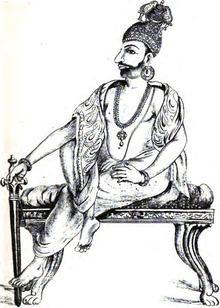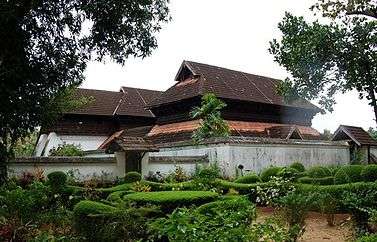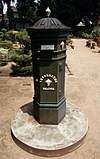Marthanda Varma
| Marthanda Varma | |||||
|---|---|---|---|---|---|
| King of Travancore | |||||
 A depiction of Marthanda Varma in A History of Travancore from the Earliest Times (1878) by P. Shangunny Menon | |||||
| Reign | 1729– 7 July 1758 | ||||
| Predecessor | Rama Varma | ||||
| Successor | Karthika Thirunal Rama Varma ("Dharma Raja") | ||||
| Born |
Anizham Thirunal Marthanda Varma 1705 Attingal, Thiruvananthapuram | ||||
| Died |
7 July 1758 (aged 53) Padmanabhapuram, Kanyakumari | ||||
| |||||
| Father | Raghava Varma, Kilimanur Palace[1] | ||||
| Mother | Karthika Thirunal Uma Devi, Queen of Attingal[1] | ||||
| Religion | Hinduism- | ||||
Marthanda Varma (born Anizham Thirunal Marthanda Varma; 1705 – 7 July 1758) was ruler of the southern Indian state of Travancore from 1729 until his death in 1758. He is most celebrated for crushing the Dutch expansionist designs at the Battle of Colachel in 1741. Marthanda Varma, then adopted a European mode of martial discipline and expanded his domain to encompass what became the modern state of Travancore.[2]
Marthanda Varma built a substantial standing army of about 50,000, reduced the power of the Nair aristocracy (on which rulers of Kerala had earlier been dependent militarily), and fortified the northern limits of his kingdom at the so-called Travancore Lines. His alliance in 1757 with the ruler of Kochi, against Kingdom of Kozhikode, enabled Kochi to survive.[3]
Travancore under Marthanda Varma did make a determined bid to consolidate its power by the use of maritime outlets. At his accession to the throne in early 18th century, the only route remaining was Thiruvithaamkoor to build an elaborate and well-organized war machine while keeping external supply lines open. The control of trade was also seen as crucial in the statecraft of the period. These principles were put into practice by Marthanda Varma.[3]
It was also the policy of Marthanda Varma to extend patronage to the Syrian Christians, a large trading community in Thiruvithaamkoor, as a means of limiting European involvement in trade. The key commodity was pepper, but other goods also came to be defined as Royal Monopoly Items, requiring a license for trade.[3] Thiruvananthapuram (English:Trivandrum) became a prominent city in Kerala under Marthanda Varma.[4] Prime ministers under Marthanda Varma - Arumukham Pillai (1729 – 36), Thanu Pillai (1736 – 37) and Ramayyan Dalawa (1737 – 56) - played a significant role in the raise of the Thiruvithaamkoor state.
Marthanda Varma's policies were continued in large measure by his successor and nephew, Karthika Thirunal Rama Varma ("Dharma Raja") (1758–98), who went on to successfully defend Thiruvithaamkoor against the Kingdom of Mysore.[3]
Early life
Marthanda Varma was born in 1705 to queen Karthika Thirunal and Raghava Varma of Kilimanur royal house.[1] Queen Karthika Thirunal - an adoptee from the Mushika Royal Family (Kolathiris) - was the senior queen of Attingal at the time (The Mushika/Kolathiri Family are a long-separated branch of the Ay/Venad Royal Family that originated in Thiruvananthapuram District and settled in Kannur District. The adoption was in continuation of a tradition of mutual adoption of girl children between the two sister dynasties). The state was ruled by chief Ravi Varma during this period.
Reducing the power of the Nair aristocracy
At the time of Varma's birth, Trippappur swaroopam (Thiruvithaamkoor) was a small chiefdom extending from Edava in the north to Aruvamozhi in the south. The power of its chief was only nominal, due to the influence of the nobles, most notably the Ettuveetil Pillamar (Lords of the Eight Houses) and the barons (Matampimar). The powers of the ruler were also to a great extent curbed by the Council of Eight and a Half (Yogakkar), the managing committee of Padmanabhaswamy Temple, Thiruvananthapuram. The rivalries of European powers like the Dutch and the English made the situation more complex.[5]
According to 19th-century historian P. Shangunny Menon, the then 14-year-old Marthanda Varma advised chief Rama Varma that the latter should sign a treaty with the state of Madurai Nayaks in order to check the power of the nobles and other rebellious chieftains. It is also known that the prince advised the chief to sign a treaty with the English East India Company.[5]
Expansion of Travancore
Varma's reign was one of constant warfare, against opponents both inside and outside his territory.[6] After crushing the power of the Ettuveetil Pillamar, Marthanda Varma turned his attention to the neighbouring petty chiefdoms. In 1731, the port of Kollam (English: Quilon) - which was ruled by a branch of the ancient Venad family to which Marthanda Varma also belonged - was defeated and its last chief was made to sign a treaty allowing the annexation of his chiefdom by Thiruvithaamkoor after his death. The chief was brought to Thiruvananthapuram and lodged almost as a state prisoner in the Valikoikkal palace. A contingent of Thiruvithaamkoor army under Dalawa Arumukham Pillai was stationed at Quilon.[5]
Marthanda Varma next turned his attention towards the little chiefdom of Marta and seized it. The neighbouring chiefdom of Kayamkulam - sensing an imminent invasion by Thiruvithaamkoor - soon allied itself with the Kochi, Purakkad and Vadakkumkur. The Kayamkulam chief was also successful in rescuing the Kollam chief from his Thiruvananthapuram prison. The allies built new fortification and strengthened their defences against the threat from Thiruvananthapuram. The Dutch East India Company also professed to support the war effort. The subsequent invasion of Marta by the Kayamkulam chief signalled the outbreak of the war. The Travancore army seized Nedumangad and Kottarakkara and prevented the joined forces of Elayadathu and Kayamkulam. Thiruvithaamkoor Prime Minister Ramayyan then lead an expeditionary force to capture the city of Quilon. But, he was forced to withdraw without accomplishing his mission.[5]
Having equipped their forces with the help of the French and the English Companies, Thiruvithaamkoor renewed a military operation against the chief of Kollam. In the campaigns that ensued the ruler of Kayamkulam was killed (1734). But the defence of the Kollam continued under the leadership of the brother of the deceased chief and Thiruvithaamkoor forces were forced to fall back once again.[5]
Thiruvithaamkoor's next campaign was against Elayadath swaroopam (kottarakara). When the chief of Kottarakara who was kept in solitary confinement in Thiruvananthapuram died in 1739 Marthanda Varma refused to recognise the claim of the senior female member to succession. The princess fled to Tekkumkur where the chief gave granted her political asylum. At this juncture, the Dutch Governor of Ceylon Gustaaf Willem van Imhoff sensed an opportunity to involve further in the pepper politics of Kerala. In 1739 van Imhoff arrived in Kochi, took up the cause of the female ruler of Kottarakara and protested against the annexation of that chiefdom by Marthanda Varma in a meeting between the two. In 1741 the Dutch reinstated the female ruler of the Kottarakara against the wishes of Marthanda Varma, who attacked the chiefdom and defeated the combined Kottarakkara - Dutch forces before finally fully annexing the chiefdom to Travancore while the female ruler fled to Kochi.[5]
Battle of Colachel (1741)
Thiruvithaamkoor then launched a series of raids on the Dutch forts in the area and captured them all. In retaliation, a Dutch artillery force landed at Colachel (Kanyakumari district) from Ceylon and conquered up to Kottar. The Dutch forces then advanced against Kalkulam, Thiruvithaamkoor's capital. Marthanda Varma, who was then in the north of his state promptly marched his forces to the south and arrived at Kalkulam just in time to prevent its fall to the Dutch.[5]
In the following battle at Colachel (10 August 1741), the Thiruvithaamkoor forces won a resounding victory over the Dutch. More than twenty Dutch were taken as prisoners of war from Colachel. Among them was Eustachius de Lannoy, who attracted the king's special notice. Eustachius de Lannoy, commonly known in Thiruvithaamkoor as the 'Valiya Kappittan' (Senior Captain) was entrusted with the organization and drilling of a special regiment, which he did to the entire satisfaction of the king. De Lannoy was raised to the rank of general in Thiruvithaamkoor army and proved of considerable service to Marthanda Varma in subsequent battles.[7]
Marthanda Varma realised that Dutch power in the region stemmed from their flourishing trade at the port of Kochi (English: Cochin). He set out to conquer the major spice-producing areas and seize the Kochi hinterland to deny the Dutch access to these trade goods. After declaring a state monopoly on pepper in Thiruvithaamkoor in 1743, between then and 1752, the king annexed multiple spice-producing areas including Kollam, Kayamkulam, Thekkumkur, Vadakkumkur and Purakkad to Thiruvithaamkoor thereby delivering a serious blow to the commerce of the Dutch.[8] A treaty was concluded between Marthanda Varma and the Dutch East India Company with both parties agreeing to live in peace and friendship. It was signed at Mavelikkara on 15 August 1753.
Following the expulsion of the Dutch, Marthanda Varma now turned his attention once again towards Kayamkulam which continued to seek help from the Dutch. In 1742, Thiruvithaamkoor forces attacked Kayamkulam possessions at Kollam and fought the Kayamkulam army led by Achuta Warrier and chiefs from Valiya Kakkanadu Madhom. Although Thiruvithaamkoor was defeated at this battle, Marthanada Varma reinforced his army with cavalry brought in from Tirunelveli before mounting an attack on Kayamkulam, which led to the final defeat the chiefdom. A treaty known as the Treaty of Mannar was signed, under which Kayamkulam became a tributary state of Thiruvithaamkoor. However, by 1746, the Kayamkulam chief once again showed signs of rebellion and when his conspiracies with the northern chiefdoms such as Kottayam, Changanassery, Kochi and Ambalapuzha came to the attention of Marthanda Varma, Kayamkulam was annexed by a final battle in which the chief fled to Kochi.
Thiruvithaamkoor now extended from Kanyakumari (Malayalam/Tamil: Kanyakumari) to Kayamkulam in the north. Following this, Ambalapuzha, Kottayam and Changanassery were also annexed to Thiruvithaamkoor by 1753. The principality of Meenachil was also annexed. In 1753 the tributary states of Kochi collectively known as Karappuram and Alangad were ceded to Thiruvithaamkoor. In 1755, the ruler of Kozhikode was also defeated at a battle in Purakkad. He was supported by the armies of some other local chiefs. This made almost all the chiefs of Kerala prostrate before the power of Marthanda Varma who was ably assisted in his military conquests by Ramayyan Dalawa, later prime minister (1737-1756) of Thiruvithaamkoor.[9]
Administrative reforms
Besides decisive military victories, Marthanda Varma brought about administrative reforms within the state revenue, budgetary and public works sectors amongst others. He also instituted a new knighthood for his loyal officers known as Chempakaraman Pillai, re-organized the commercial sector and monopolized the spice trade. New roads and inns were opened throughout the state with military outposts. Water transport from Varkala, Thiruvananthapuram to Cochin was implemented under Marthanda Varma while he also renovated the Padmanabhapuram Palace and built Krishnapuram Palace, Alappuzha.

Marthanda Varma also made villages the most basic sector of the kingdom and created a post known as the Mandapathu Vathilkkal, similar to the later tehsildar. He paid special attention to improving agriculture in the state. The portions of land lying east of Nagercoil, Kanyakumari called Nanjil Nadu was considered the granary of Kerala due to its extensive cultivation of paddy rice. The fertility of this area was only due to the irrigation facilities introduced by Marthanda Varma. His edicts on the subject of irrigation issued between 1729 and 1758 fill several pages in Travancore Land Revenue Manual by R Mahadeva Iyer. Only due to the digging of new canals for irrigation during his reign, the single-crop paddy fields of that area became double-crop fields, almost doubling their production.
Pallikondan dam, Chattuputhoor dam, Sabari dam, Kumari dam and Chozhanthitta dam, all on the river Pazhaya in the vicinity of Nagercoil, were constructed by him and are still operational. Near Bhoothappandy, Chattuputhoor dam was constructed and a new channel named Puthanaaru was dug from it to irrigate the Thovala areas. Puthan dam, built by him near Padmanabhapuram, provided drinking water to that area.[10]
Culture and religion
Padmanabhaswamy Temple, Thiruvananthapuram was re-created as the gigantic structure of today and new state ceremonies such Murajapam, Bhadra Deepam and others were introduced by Marthanda Varma. The main idol of the shrine, which was mostly destroyed in a fire during his predecessor Rama Varma's time, was also re-constructed using Salagramas imported from Nepal. He also created Ottakkal Mandapam as well as the Sheevelippura. Out of the seven floors of the temple-gopuram, five were finished during his reign.[11]
As a result of the annexation of neighbouring places, the artists and scholars from these places migrated to Trivandrum, turning it into a cultural centre. Marthanda Varma gave patronage to different temple art forms including Koothu, Padhakam, Kathakali, Thullal and Koodiyaattam. Noted artists such as Ramapurathu Warrier and Kunchan Nambiar amongst others served as his court poets.[11]
Thrippadidanam
Marthanda Varma decided to "donate" his realm to Sri Padmanabha (Vishnu) and thereafter rule as the deity's "vice-regent".[12] The dedication took place on January 3, 1750 and thereafter he was referred to as Sree Padmanabhadasa.[13]
The title of Sree Padmanabhadasa was prefixed to the name of every Travancore king while the women were Sree Padmanabhasevinis. In order to be eligible for the title of "Sree Padmanabhadasa", certain rituals had to be completed. On the first birthday of every royal male, the child would be placed on the 'Ottakkalmandapam' of the Padmanabhaswamy Temple and holy water from the temple would be sprinkled on the baby. Only after completion of this ceremony was the royal child proclaimed as "Sree Padmanabhadasa" in a ritual known as Adimayidal. Female royals also underwent the Padiyettam ritual, which was conducted only after their 'Pallikettu'. Only those male and female members who completed these ceremonies were allowed in the temple affairs and were also provided respect as well as the titles associated with temple as well as the royal family.[13]
Death
Prime Minister Ramayyan Dalawa's death in 1756 caused Marthanda Varma great pain. Not only had Ramayyan Dalawa been his minister but also his friend. The king's health began to deteriorate thereafter and he died two years later in 1758. Before his death, Marthanda Varma summoned his nephew and successor Karthika Thirunal Rama Varma and gave his final instructions. These mainly concerned maintenance of all the poojas and ceremonies as well as other matters concerning the Padmanabhaswamy Temple without attempts to meddle with them. Another instruction was that the expenses of the state should never exceed its revenue while no infighting in the royal family was to be ever allowed. Within a short time of these final instructions, the king died at the age of 53.[14]
References
- 1 2 3 Mheshwari, S Uma. Thrippadidaanam. Mathrubhumi Books. pp. 41–53. ISBN 978-81-8265-947-6.
- ↑ "Kerala". Encyclopædia Britannica. Encyclopædia Britannica Online. Encyclopædia Britannica Inc., 2013. Web. 22 Oct. 2013 .
- 1 2 3 4 "India". Encyclopædia Britannica. Encyclopædia Britannica Online. Encyclopædia Britannica Inc., 2013. Web. 22 Oct. 2013 .
- ↑ "Thiruvananthapuram". Encyclopædia Britannica. Encyclopædia Britannica Online. Encyclopædia Britannica Inc., 2013. Web. 22 Oct. 2013 .
- 1 2 3 4 5 6 7 Menon, A. Sreedhara (2007). A Survey Of Kerala History. DC Books.
- ↑ Kooiman, D. (1992). "State Formation in Travancore: Problems of revenue, trade and armament". In Heesterman, J. C.; Van den Hoek, Albert W.; Kolff, Dirk H. A.; Oort, M. S. Ritual, State, and History in South Asia: Essays in Honour of J. C. Heesterman. BRILL. p. 600. ISBN 978-9-00409-467-3.
- ↑ Srinivasan, Rajeev. "The Battle of Colachel: In remembrance of things past". Rediff On The Net. Retrieved 12 March 2014.
- ↑ Sharma, Yogesh (2010). Coastal Histories: Society and Ecology in Pre-modern India. Primus Books. pp. 83–84. ISBN 978-93-80607-00-9.
- ↑ Menon, A. Sreedhara. A Survey Of Kerala History. pp. 224–228.
- ↑ Menon, A. Shreedhara. A Survey Of Kerala History. pp. 225–227.
- 1 2 Gauri Lakshmi Bayi, Aswathi Thirunal (1998). Sreepadmanabhaswami Kshetram. Thiruvananthapuram: The State Institute Of Languages. pp. 152–168. ISBN 978-81-7638-028-7.
- ↑ Chaitanya, =Krishna (1983). A History Of Indian Painting : Pahari Traditions. Abhinav Publications. p. 88. GGKEY:Y12G5FWSUHB.
- 1 2 Aswathy Thirunal, Gauri Lakshmi Bai (1998). Sree Padmanabhaswamy Kshetram. Thiruvananthapuram: The State Institute Of Languages, Kerala. pp. 168–170, 179–180, 595–602. ISBN 978-81-7638-028-7.
- ↑ Gauri Lakshmi Bayi, Aswathi Thirunal (1998). Sreepadmanabhaswami Kshetram. Thiruvananthapuram: The State Institute Of Languages. pp. 178–179. ISBN 978-81-7638-028-7.
| Wikimedia Commons has media related to Marthanda Varma. |
Marthanda Varma Born: 1706 Died: 1758 | ||
| Regnal titles | ||
|---|---|---|
| Preceded by Rama Varma (as raja of Venad) |
King of Travancore 1729–1758 |
Succeeded by Rama Varma (Dharma Raja) |
